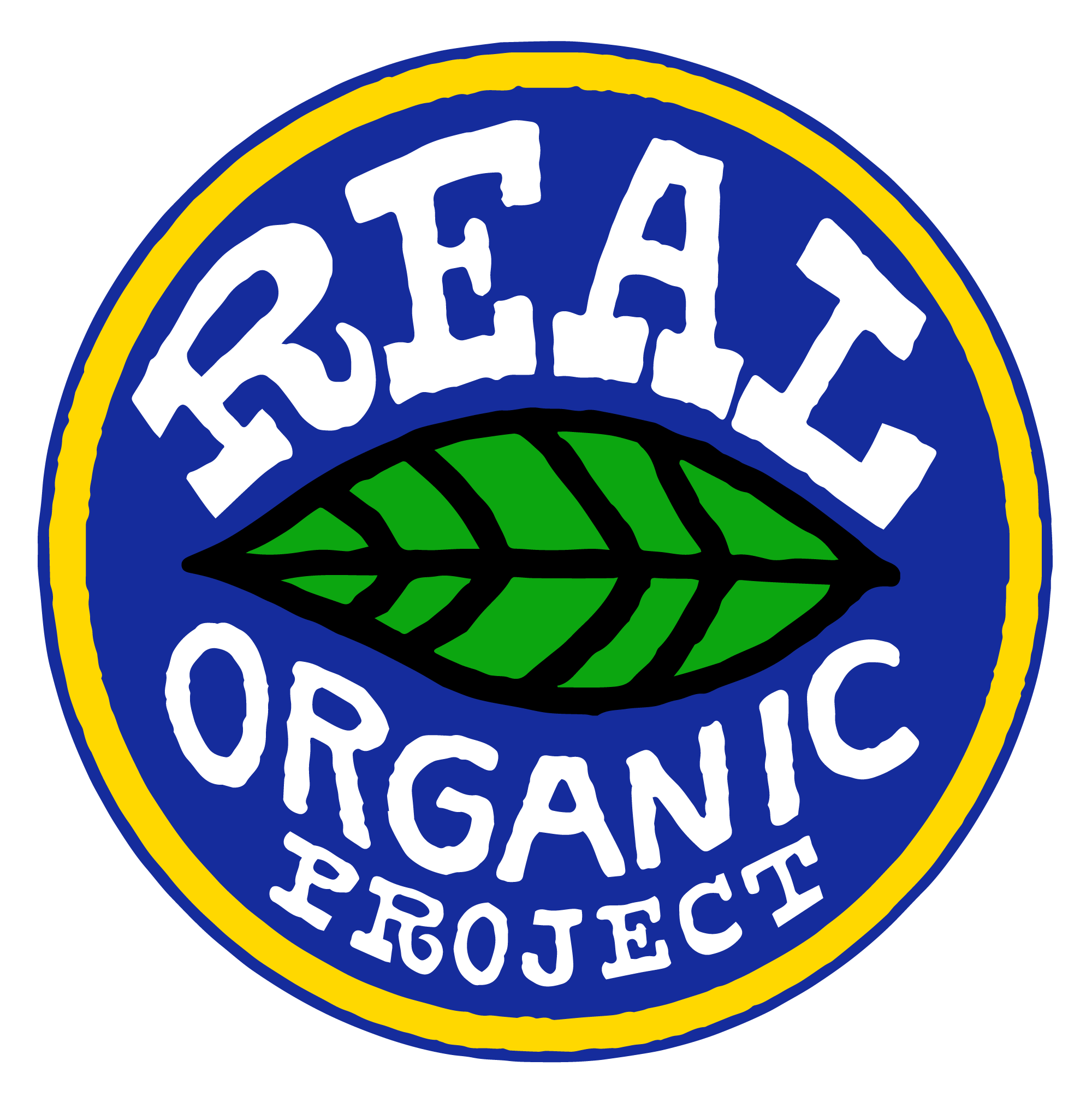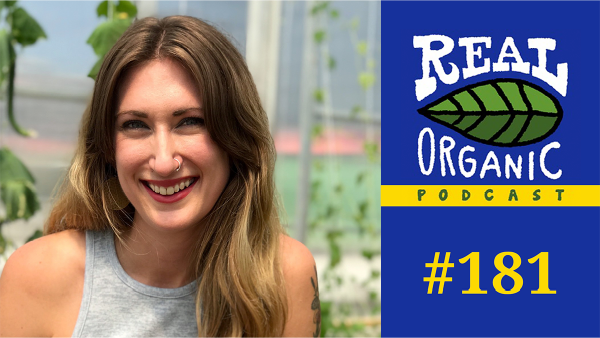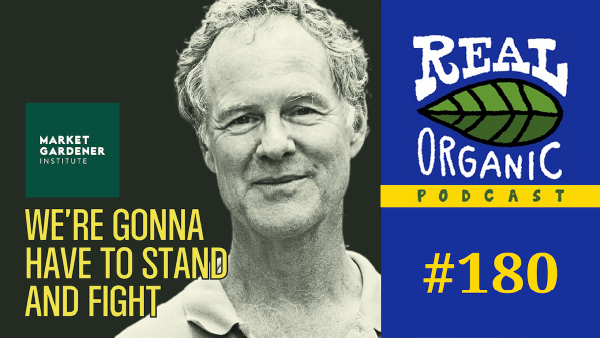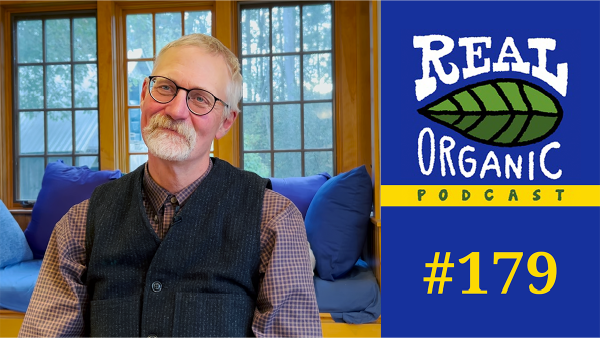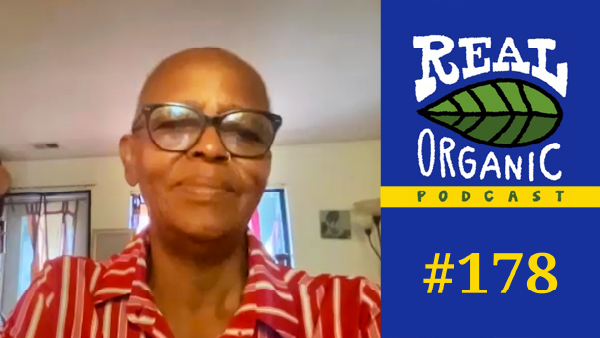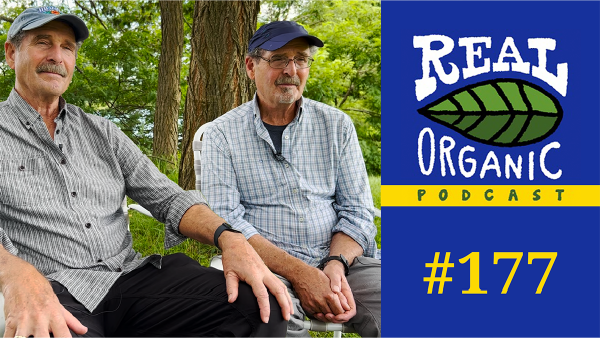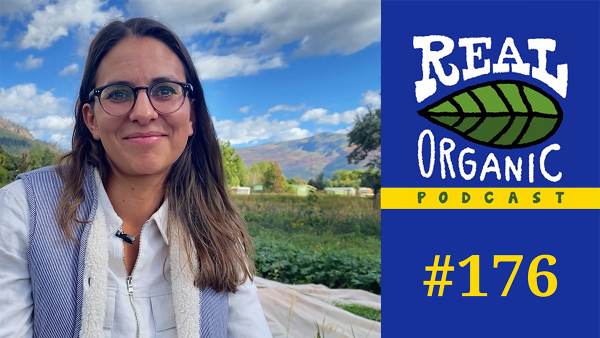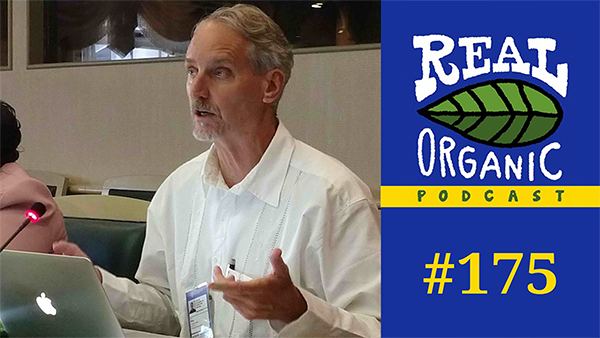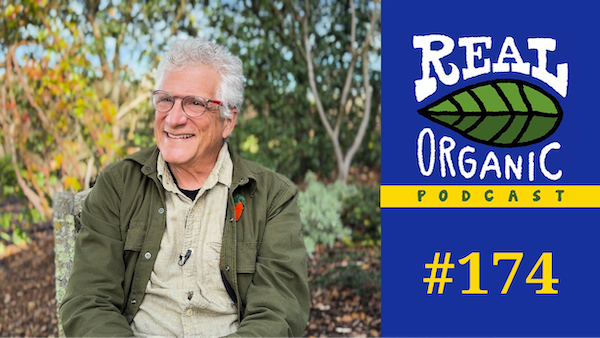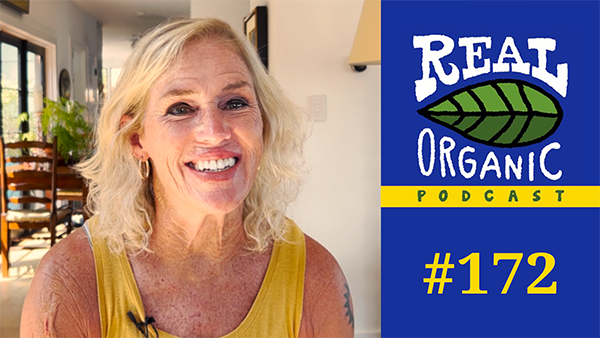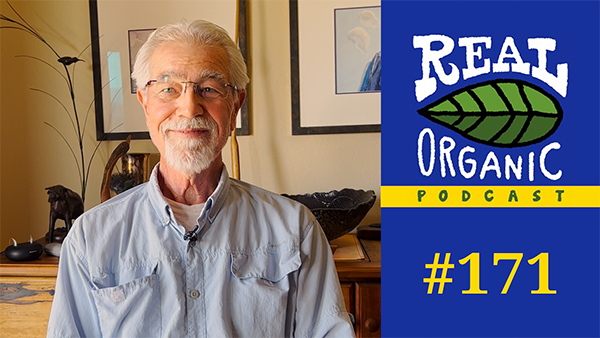Episode #173
Glenn Elzinga Pt 1: Good Grazing On Public Lands
Welcome! You can subscribe and download episodes of our show through your favorite podcast app.
You can also subscribe to receive the video version of each episode on our YouTube channel.
Our Glenn Elzinga interview has been edited and condensed for clarity.
Dave Chapman interviews Glenn Elzinga, September 2023:
Dave Chapman 0:00
Welcome to The Real organic Podcast. I’m very happy to be talking with Glenn Elzinga, my friend from Idaho, a rancher, who just does extraordinary things, and is very generous sharing it with the rest of us. Glenn, I just, I just got to hear you give that talk two days ago at the conference in Churchtown. And it was the most beautiful, beautiful thing that you presented of this life. And I know it’s not, the Sound of Music. And I know that, you know, the real life is got its serious challenges, like every real life, but you do, you do live in a beautiful place, that smells good.
Glenn Elzinga 0:46
Yeah. Yeah. No, we get, we get to work in beauty.
Dave Chapman 0:51
Yeah.
Glenn Elzinga 0:51
That’s for sure, Dave.
Dave Chapman 0:52
Yeah.
Glenn Elzinga 0:54
Sometimes it’s not always beautiful feeling, but it is beautiful. And I gotta tell you right now, it’s my daughter’s who really, are really gifted at capturing that on, you know, they actually bring a decent camera with them. Because they know, it’s important to capture that, because it’s unique. It is a unique place. And they I think part of it for them really is not just to represent it, but I think there’s this respect in all of them, to represent it right.
Dave Chapman 1:23
Yeah.
Glenn Elzinga 1:24
You know, because the beauty of it, you know, so it becomes so much a part of them that it’s like, no, no, no, you don’t bring a cell phone up here. And capture. Yeah, yeah, they do. I’m all of them take cell phone pictures. Yeah. But you don’t bring, you know, a cell phone to, you know, the coronation of King Charles or whatever, you know, it’s kind of a different vibe but you know, they have this respect for the land, and they want to represent it right.
Dave Chapman 1:51
Yeah. So help, help people, you know I hope that everyone’s gonna listen to your talks. They’re gonna learn a lot of this, but, but give me a little bit of a context, how many acres is it that your ranch occupies?
Glenn Elzinga 2:06
So it’s about, it’s about 3000 acres deeded. But we actually say it’s a 50,000 acre ranch, because we actually control 50,000 acres, it’s leased ground from the US Forest Service and BLM. They’re both government agencies. And there’s some state land in there, too. And mixing all that is our private ground.
Dave Chapman 2:28
You took a you took a picture of this vista?
Glenn Elzinga 2:32
Yeah.
Dave Chapman 2:32
That went into the mountains in the distance.
Glenn Elzinga 2:34
Yes,
Dave Chapman 2:34
And you said all of this is part of it.
Glenn Elzinga 2:36
Yeah, that was that, was a cool picture because I was like, looking for one in that talk with that I could kind of represent that just to get, you know, somebody says 50,000 acres, and you’re really not cognizant of what that means. And you know, I could convert that to miles and say, Oh, it’s 70, 75 square miles, you know, and that sounds cool. But it’s really meaningless. Because you know, people, you know, in order to get the visual, you need a visual, right? You know, you don’t just go visualize 70 square miles, or 47,000 plus 3000 acres.
Glenn Elzinga 2:36
So anyway, I wanted to pick that one picture, and I found that one, Melanie took that of me, and it was we were on a scouting mission, we’re way ahead of the crew and about 450 head of cattle. And it was she and I just traveling across what we call the Tablelands. It’s called the Larkspur Tablelands it’s this kind of unique area on that grazing country, and, you know, I haven’t been up there for many years, I’ve been working in that country for probably, oh, it’s been 35 years. And we came over that break that day, I was riding ahead of her on horseback. And you know Dave, it just still took my breath, it took my breath away.
Dave Chapman 3:59
Yeah.
Glenn Elzinga 4:02
You know, I can’t even put words on it just really gets under your skin. Because you, you start to learn and, you know, the more you get to know, you know, it’s like being married to somebody for you know, 35-40 I talked to a couple that was married 65 years the other day and you know, there’s nothing superficial it’s very intimate, you know, and that’s the way it’s become with this piece of country.
Glenn Elzinga 4:28
Because, you know, I can mention a rock, a rock out in the middle of 100% nowhere or a given Douglas fir tree in the middle of 100% nowhere to one of my kids and guess what? They know the rock or they know the tree. Anyway, this picture was was unique because it went all the way to the skyline and you know, from one side of the image to the other, and everything on it, everything in that picture all the way to the horizon line miles and miles away was part of this, this piece of country.
Dave Chapman 5:02
So, so one of the things I really got from your talk was this message that you and your family, and the animals that you manage and take care of, are part of the ecosystem of that land.
Glenn Elzinga 5:18
Yeah.
Dave Chapman 5:19
It’s not like the ecosystem is separate, you are woven into that ecosystem. And you seem to have a pretty clear understanding that your choices strongly impact, impact that large span of land.
Glenn Elzinga 5:40
For sure, you know, Dave, we didn’t always have that. It, you know, it’s all about what’s happening up here, really, you know, as you know, if you’re working on three acres, or you’re working on 50,000 acres, or 100,000 acres, it really is about, you know, what your, what your mind, where your mind is in regard to that relationship over, what you have to work with. And I won’t even say what you’re managing, because that would be like, way too limiting for me to say we’re managing this ground. Because the ground ends up managing us to a lot of degree when we, when we get our head right.
Glenn Elzinga 6:29
You know, so what we were doing early on was we were actually trying to say, Oh, we’re gonna put cattle up here, and we’re gonna graze this and we’re gonna graze that and we’re going to try to manage these riparian ecosystems to try to get them to function while trying to get get our cattle gain weight. And the uplands we’re going to use this stubble height criteria to measure how much we graze here, and we’re going to calculate out and it’s going to be like, you know, 25, 30, 40 pounds per acre start with hopefully, we’ll get to 100 pounds per acre and a stocking rate, you know, you got all these metrics and all this stuff. And we came to a point my wife and I, to this place where all of that just fell along the wayside.
Glenn Elzinga 7:18
In fact, I was in a discussion with a bunch of scientists in Montana the other day, and they started talking about, they start using those terms, they started using terms like stocking rate, and pounds of dry matter per acre, and, you know, average daily gains and all these cool things, which are super valuable metrics, you know. But they were talking about a wild landscape. And the landscape before we came along, were so wild that bison would come by and it might be 50,000 head of bison run across this piece of ground in three days, and they annihilate it. You know, they eat every blade of grass.
Glenn Elzinga 8:03
I’ve read trappers’ journals where, you know, like this, this guy was coming up this canyon, and it’s very close to us just a few few miles away, and he was coming up this canyon with his pack string, it was 1824. And he’s leading his pack string and it’s a tight, tight canyon in Idaho’s Rocky Mountains. He’s surrounded by these canyon walls, and all sudden he feels a breath of hot, humid air. And his horses start getting really unsettled. They start jostling, you know, he’s got them in a pack string. He’s leading them with lead ropes, they start jostling around and looking behind, they’re nervous or, you know, they start just waving, you know, from side to side with their feet. He knows something’s up and all sudden something triggered in his head. He said, bison. They called them buffalo in those days. He’s like, buffalo. He knew. Buffalo.
Glenn Elzinga 8:58
He galloped with his pack string to a big Doug fir tree, and tied his horses all to low branches under a tree and climbed up the tree because he knew he had to be free. He had to be free and clear of the ground. And sure enough, that hot wind hit him like a ton of bricks and you know, with this huge fervor and odor of animals. And the leaders came through and it was like, it was like 100 bison wide at the bottom of this canyon, and they just stampeded right by him. He was stuck in a tree for the entire day, into the next day, he spent the night in this tree while this herd ran by.
Glenn Elzinga 9:37
So I went there. And I was like, I’m going to calculate this. I’m going to figure it out. You know so I found out how bison how fast they go, you know, and you know I just figured a trot. I didn’t even figure at a gallop I just figured a trot. You know take that and you know, square root…of nine times 42 times, divided by, you know, whatever, you know, I just did the numbers. And how many bison you could fit conceivably across there, they were in stampede.
Glenn Elzinga 10:04
And the time frames he talked about and minimum number I could come up with was about 400,000 head of bison ran by this guy. Anyway, the dust settles a little bit and there’s a few stragglers coming by he gets on his horse again and starts riding. Horses are hungry, and thirsty. And there’s a creek nearby. It’s a mud hole. And they tried to get a drink out of it. Anyway, he rides over and into the next valley, which is ours. And he’s thinking we’re, we’re gonna graze over there because this canyon bottom is annihilated. He never found a blade of grass. I mean, this is a big valley, Dave, this valley is 45 miles long by 10 miles wide. 100% annihilated everything is eaten down to, it’s like it burned. You know, except it wasn’t black, these bison, it’s 400,000 head, they just torched it and moved on.
Glenn Elzinga 11:03
And so, you know, when, when I got context to that, like in form of disturbance of our ecosystems, I’m realizing all bets are off as far as your metrics, it’s all meaningless, because it’s a wild ecosystem and what the reality is, is anything can happen with these grazers. I mean, it may be 25-30 years before these bison come back, or it might be two years from now. We have no idea. Maybe we have an average return interval of 10 to 20 years, I don’t know. So that’s the kind of things we started to try to figure out…is how can we emulate? How can we emulate nature, and these episodic events, with how we manage and how we influence this ecosystem. And that shift of thinking, then would take us to place, we’re now part of an ecosystem, instead of acting upon it, you know, we’re trying to mirror what these plants, the conditions that these plants have adapted under, you know, these riparian systems, the creeks, and it’s, you know, the springs and ponds and the lakes, all those things, you know, they adapted under certain sort of criteria, you know?
Glenn Elzinga 12:18
Whether it’s episodic events like this, or maybe it’s just the, the nighthawks coming back every year. They come back every year, at a certain time, every year, within a one week period of the night hawks are back. It’s like somebody turns out, switch, boom, they’re back. You know, so there’s all these different layers of functionality in the ecosystem. And what we realize is that, we just want to emulate one part of that. And, as a result, hopefully, we’re trying to be part of that ecosystem now, instead of influencing.
Dave Chapman 12:52
And the impact of that, in your experience has been clearly that the ecosystem is changing in ways that you would consider very positive.
Glenn Elzinga 13:04
Oh heck, yeah.
Dave Chapman 13:05
Right.
Glenn Elzinga 13:06
Yeah. No, incredible.
Dave Chapman 13:07
Yeah.
Glenn Elzinga 13:07
Very incredible change. It’s like even something as, you know, esoteric, and out of reach as soil organic matter as near as we can tell, you know, I know it’s dry this semi desert. This is semi desert, rain shadow environment, you know, like, probably mid range precipitation at mid elevation. In the sagebrush ocean part of the ecosystem is, you know, it’s somewhere around 15 inches a year. And we had a gal named Nicole Masters. She’s an agro ecologist.
Dave Chapman 13:40
I know Nicole.
Glenn Elzinga 13:40
From New Zealand. She actually lived with us for a while, up there, and she was horseback with us on crew quite a bit. And which, Nicole is fantastic, because she doesn’t take life too seriously and she laughs a lot. So that’s very good in our situation. That makes for a great day with Nicole.
Glenn Elzinga 13:59
But anyway, we’re out there. And she’s actually got this protocol for measuring land health. And we, so we took that protocol, and we applied it to a community system that…is very vulnerable to this long term grazing, this long term continuous grazing effect that people have put on this…this ecosystem, remember, it’s not a part of the ecosystem, it’s an influence on the ecosystem. And so there’s been 150 years of continuous grazing people just stuck their cattle out there. And then they’d go find them in the fall and bring them home, you know, bring them home to the valley where the ranch was, and they’d throw him in the mountains every year did this for about 150 years, and it was a lot of cattle for quite a while it was 1000s and 1000s, head of cattle, and it completely changed the balance of plant communities up there. So now we’ve changed to a very…. very short duration high intensity grazing paradigm, that’s separated by an average of 3.5 to four years.
Glenn Elzinga 15:07
So, sometimes like this year, most of the country we graze hadn’t been grazed for 12 years. And, some of the stuff, we grazed just three years ago, you know, that we pass through. So there’s quite a bit of variability. Remember, like the bison could be extremely variable. But yet, you know, we’re looking at an average of somewhere between four and six years. And the other thing about it is we’re using this high intensity, short duration. So it’s actually measured in minutes, the amount of time we spend on a given acre of ground is maybe two to four minutes. And for the total four year period.
Dave Chapman 15:46
Right, and that’s bringing a herd of like 400-450
Glenn Elzinga 15:50
Yes.
Dave Chapman 15:51
Cattle…in for four and a half minutes. Yes.
Glenn Elzinga 15:55
And you’re just moving through, and it’s not like they’re running or anything, they just get their heads down and they’re continuously grazing. But this is the way you know, when you when you allow animals to represent what’s inside them. They’re instinctual grazers, when you allow them to represent what is inside them, what is inside them genetically, as far as instinct, they are, take two steps and take one bite, take two steps and take one bite, take one step and take, they’re always moving, there’s a, there’s a body orientation that’s general in a direction while they’re getting their belly full.
Glenn Elzinga 16:30
These animals, you know, prehistorically, you know, even you know, the aurochs they came from, you know, they were always moving, they were always like moving to select new graze. And, you know, part of it was to allow them the chance to experience 100% nutritive choice that was determined by palates, you know, so, these animals all have a palate, you know, we think cows are dumb, stereotypically. And, you know, I actually think there’s some humans that are dumber than cows after I’ve really met a cow at their, his or her, own terms and allowed them this, this thing of full nutritional choice. They’re very discretionary about what they eat.
Glenn Elzinga 17:15
But we as humans have reductionalized this, you know, especially in terms of feedlot, but even in pasture systems, we put them on these monocultures, or maybe it’s a polyculture, with only five species or something like that. And, as a result, they can’t really self regulate and follow what their palate is. They’re just trying to get their belly full, you know, it’s like, we’re just gonna give you spaghetti every day as a human, and it’s gonna get your belly full. But of course, you’re yearning for all these other things, and all these other flavors, and, you know, chemicals, probably to experience in your palate and tastes, and you know, but no, we’re just gonna give you spaghetti, and maybe we’re gonna give you some iceberg lettuce every day, you know, and that’ll give you the greens and the fiber you need, plus, you’ll get some carbohydrates. You know, let’s not worry about protein right now, because we’re trying to put weight on you.
Glenn Elzinga 18:03
So I mean, that’s kind of, you know, in a microcosmic way, the way we’ve treated cattle, and the way we’ve made them become, and what we’ve realized is that, we need to kind of reboot that instinct of following their palate. Because when they have their own nutrient of choice, and it’s through biodiversity, you know, a biodiversity of huge food choices in front of them, they’re going to be able to self regulate their own wellness. And that, that’s where it becomes super exciting to start seeing that take off. So it’s not only taking off in the ecosystem, but it’s taking off in our animals themselves.
Dave Chapman 18:49
So this is really interesting. Of course, you’re saying the greater the diversity, then the wisdom starts to come of making the…
Glenn Elzinga 19:00
Yes, exactly
Dave Chapman 19:00
intelligent choice for that animal. And in a pasture with five species, they can’t they can’t make such choices. They still make some, and in a feedlot they can’t make any choice at all.
Glenn Elzinga 19:13
Yeah, it’s over. Yeah.
Dave Chapman 19:14
And they just get, they just eat what’s there and eat a lot of it. It’s not healthy for them.
Glenn Elzinga 19:19
No, it’s not. I mean, you know, it’s manifested by acidosis. You know, you start getting lesions in their guts, you know, ulceration. Fact is a lot of a lot of feedlot cattle are going to die soon on their own and just because of sickness, you know, they’re gonna start developing all these characteristics of, you know, the high acid environment they…they’re grazing on, you know, which is corn or maybe it’s ground barley, beet pole. Maybe it’s even, you know, really weird things to try to supply roughage like newspaper waste or whatever. There’s all kinds of, when you want to talk about what’s fed to conventional beef cows in feedlots, like for me the worst one of all is this dry distillers grains, it’s probably one of the most common feed stuffs, and these are byproducts of ethanol production.
Glenn Elzinga 20:10
And they’re just not healthy. They’re just, it’s an extremely dicey thing to feed without trying to figure out how to mitigate the toxic effects of dry distillers grains. And yet, most cows in the United States, most cows and steers, heifers that are in a finishing paradigm, you know trying to get fat on, are fed that. And you need an animal nutritionist to figure out how not to kill your cow, you know, when you’re feeding this. So you know, to me, that’s the reductionist, fully and falling-off-the-cliff spectrum versus what we do, where we just say, no girls, here’s 2500 different plant species. Or guys, you choose what you want.
Glenn Elzinga 20:56
What’s really crazy Dave is we, we buy some organic grass finished cattle from a few other producers, most of them now we raise from calves. But you know, it takes a lot to both raise the babies on your own place, as well as, you know, take them all the way to finish. So, you know, for years, that was our predominant input was we bought grass fed organic cattle, from producers in Montana, they were great people, friends of ours. But a lot of them came from prairie ecosystems.
Glenn Elzinga 21:39
So these yearling cattle would come into our place. And my girls noticed this first, we take them up to our grazing country with our other cattle. And we saw these, these yearling cattle walking around aimlessly. They, you know there’s tons of plants in that low country that they enter in when they come off the ranch. And they’re walking around out there, and they’re just, they’re not eating, you know, and you’re like what’s happening and then, I think it was Melanie started noticing this phenomena. So we had some older animals there, too, you know, that were, that, you know, been with us forever. And were there for, you know, this is their second year up on the range, or maybe, you know, coming into third.
Glenn Elzinga 22:27
And so these younger cattle would go and put their head right next to where this cow was grazing. Because they got up there, and they’ve been looking forward to it, they actually looking forward to going up there because I think it’s because of nutritional diversity. I mean, we have a lot of cool choice at home, we have 85 species on our home pastures. But it’s like they start like looking for the gate, when the weather starts changing. They know it’s time, it’s time and for them, it’s like, I think it’s this time of unparalleled choice. And for a cow, that’s paradise, to have unparalleled choice.
Glenn Elzinga 23:05
And they’re already very comfortable with us. And so we can ride horseback, you can’t walk onto the ground right next to him because it’s different, it’s you know, when you’re on horseback, they feel like you’re part of them. When you’re on foot, you’re human. So you’re riding up to him right on horseback to get their heads and right next to him is one of these yearling cattle and son of a gun. It’s only a few days of this, we call it nutritional training, these young cattle will put their heads next to the older animal, and will start taking bites. I mean, they are right next to it, it’d be like you sitting at a dinner table at a restaurant, and you just putting your mouth right next to somebody else’s plate. And, you know, taking their fork from their hand and just shoveling it’s equivalent today. And it’s kind of weird, but, you know, they didn’t trust their own discretion to know what was good and what wasn’t. But they would trust another bovine to show them and tell them. And, you know, within two days, their bellies were now full. And it was just because of this nutritional training that the other showed them.
Dave Chapman 24:12
That’s a very important thing, Glenn obviously, that, yeah, there’s instinct here.
Glenn Elzinga 24:20
Yes.
Dave Chapman 24:20
But there’s also learned acquired knowledge.
Glenn Elzinga 24:23
It’s huge. It’s huge.
Dave Chapman 24:25
That’s huge. They’re learning. Yeah, this is good for me to eat. It’s okay to have a nibble of that, but not too much. Don’t eat that. Yes. Right.
Glenn Elzinga 24:35
Yeah, no, it’s 100% trained. Now, you know, there’s some instinct in there too. But to get those cattle going, it required so much training and it wasn’t me. It wasn’t me, it was them training each other. So, you know, that was really the other thing that they really are amiss on is how to be a cohesive member of a herd, and you know, that I think is instinctually in them as well just because if you were an outlier and you weren’t following the herd, guess what you were, you were meat. You know, you became, you went from aurochs or you know, former bovine, into meat land because the predators got you so because you left the herd.
Glenn Elzinga 25:20
So sometimes that is them observing. Most times, it’s them observing the cohesiveness of the herd from the ones who had been practiced in it last year. They kind of stick together, they’re, you know, they’re social animals, and there’s not many of them that are antisocial, have antisocial tendencies, but some of them do. And so, you know, I didn’t know what we could do about that. So because we, we’d go on horseback and try to bring them back in.
Glenn Elzinga 25:54
And one day I was out on hills with this…this friend of mine, his name is Steve Cody, and he was a student, direct student of this guy named Bud Williams, a stockmanship expert who is like, a counter intuitive human, animal behaviorist, you know, he didn’t take a human element into animal behavior. He actually, I think he liked cows better than people he actually took, took a cow and sheep mindset into animal behavior. And because of that, a lot of people disregarded because he was 100%, non-traditional, cow handling, and it was always on the side of a bovine. Ray Hunt was another guy who actually did the same kind of viewpoint of horses. He actually saw things, he was greatest horse advocate…probably that ever lived.
Glenn Elzinga 26:50
And so what he told me is, Glenn, you’re thinking about this all wrong, you can’t put them back in a herd. You want to drive them away from the herd. And I said, What are you even talking about Steve, he said, get on your horse, and run them as hard as you can away from the herd, just as hard as you can. And as long as they’re looking forward, you just keep running, you just send them on down the road they want to go, just keep going. But he said the second they turn around and look back, just do this. You free, you go free, and you just back off all pressure. He said, I almost guarantee you have trained that animal to never leave that herd again.
Glenn Elzinga 27:30
And what I didn’t realize he was doing was he was being a predator, he was being a top of the food chain predators saying, I’m gonna cut you out. And I’m gonna kill you. You know. So all of a sudden that fear instinct comes in, they are prey animals after all, and you’re kind of what you are is confirming that instinctual thought in their mind and saying yes, that’s right. This is actually very dangerous for you to leave the social network of the herd. So anyway, one of my girls this year actually pinned it down. It was Linnea. And, you know, created this new idea for us that we now do in spades, you know, so soon as an animal heads off.
Glenn Elzinga 28:13
We have always a bunch of Border Collies working with us, she’ll send the dogs after them. And you know, it sounds cruel, but she’ll send the dogs after him and now guess what, they are actual predator feeling animals and these dogs want to go, just want to go after that recalcitrant steer who doesn’t want to have a you know, social network of the herd to protect them. Because we do have wolves up there. We need this to be intact. We have a lot of wolves up there who would easily take one of these cattle out and enjoy some grass fed organic beef.
Glenn Elzinga 28:43
So anyway, Linnea sends the dogs after them, there’s like three dogs after this, this poor steer who’s now like terrified. And the second she sees that animal starts circling or turn its head back, she’ll call the dogs off. And they come. I mean, our dogs are pretty well trained. And they come. They break off and that cow, that steer, that heifer, whatever it is, runs full speed back to the herd. And, you know what, more often than not, we never hear from that one again. They’re now adopted into this natural paradigm that was inside them, instinctually But it took us to kind of reboot that.
Dave Chapman 29:24
Yeah.
Glenn Elzinga 29:25
So we have we have a situation being humans, which is interesting, because when we stick with the herd, what we’re taught is to eat junk food. Right that’s…that’s the norm.
Glenn Elzinga 29:44
Yes.
Dave Chapman 29:45
Is super processed foods that really aren’t very good for us.
Glenn Elzinga 29:49
Yes.
Dave Chapman 29:50
But somehow, something strange has happened in our world. Where you’re a wacko if that’s not what you want to eat.
Glenn Elzinga 30:00
Right.
Dave Chapman 30:01
If you put your head down to somebody else’s, you’re gonna come back with Doritos.
Glenn Elzinga 30:05
Yes, you’re right.
Dave Chapman 30:06
What do you think about that? How’d that happened?
Glenn Elzinga 30:09
You know? Have you read this book by Mark Schatz, called the Dorito Effect? I
Dave Chapman 30:17
I sure have.
Glenn Elzinga 30:17
Okay, I have too. Mark is actually a really good friend of mine, he and I have actually been on a range together talking about this very thing. And he’s actually always, you know, looking at these cattle and…applying a lot of these same stories to how cattle work to humans, you know, and how we develop our own palates. But see now Dave, for 100 years, maybe not quite that much. But 60 or 70 years, our palates have been affected by, by flavors, by processes on food, that are lying to us. And our body is still telling us Yes, they’re nutrition, even though just there’s some compounds placed in there that indicate to our bodies that are nutrition, but they’re not. They’re not nutritious at all. Doritos are not nutritious. And there’s things in there that say, Keep eating them or things in us actually to say keep eating them.
Glenn Elzinga 31:18
Because actually, you know, the nutritional markers are there, the chemical markers that say this is nutritious food are there. But yet we’re never sated, because no true nutrition has ever been reached. And our body will tell us when true nutrition has been reached by, you know, saying yes, I’m satisfied, I’m full because biochemically our needs are met. Biochemical needs are not getting met. And as a result, we just keep eating. And this is why, obesity. I mean, this is a really simple reason why obesity, it’s because our nutritional needs…are not getting met, yet our palates are being satisfied, our seeking out of taste, you know, that’s why sugar, it’s like, yes, you know, adaptively, prehistorically, we are attracted to sweet things simply because of the energy component that they offer us.
Glenn Elzinga 32:12
However, in this day and age, we’re surrounded by those kinds of options. And, you know, prehistorically, you and I have never ate that much sugar. It just wasn’t out there, in the world. It wasn’t in the, you know, my ancestors were brought up on the North Sea, you know, 1000s of years. And, you know, guess what we’re eating aurochs, we’re eating seafood, we’re eating, maybe some seaweeds, and maybe some wild berries. There was not much else to eat out there, there was no sweet choices, there was no easy green choices to eat prehistorically for, you know, my tribal ancestors, and they were healthy, you know, they had good teeth. They were doing great. But now we have an industry that’s built on just satisfying the palate, and not satisfying our needs. And as a result, here we are.
Dave Chapman 33:05
I thought that story that Kristen Kimball told about the young little girl who was visiting their farm, and she wouldn’t eat any of this incredibly good food, right? Because it wasn’t what she’s used to. It’s just like, the cow that you bring in. And they’re not used to eating Yes, any of these species, and so they’re not eating it. Yes. And finally,
Glenn Elzinga 33:28
they’re not recognizable right?
Dave Chapman 33:29
Right.
Glenn Elzinga 33:30
Not even on their radar. As far as that’s not even food. I don’t even consider that food. Right?
Dave Chapman 33:35
Right. And the little girl was like that. Even strawberries weren’t food.
Glenn Elzinga 33:39
Yes.
Dave Chapman 33:39
And they had to take her to McDonald’s 40 miles away, to get her to eat. And I thought, wow, that’s really actually kind of like what you’re talking about. Except the opposite. It’s like taking a smart, a smart cow. Yeah, that has a choice of 2500 species plant species and knows how to do it. And they’re put in a feedlot.
Glenn Elzinga 34:00
Yes. And we’re trying to dumb down, Dave. We’re dumbing them down. And it’s 100% nothing to do with their wellness. It’s 100% to do with our market. We’re just trying to put fat in beef to get marbling and minimize the amount of time they’re on feed. So it’s all about feed conversion efficiency to find fat marbling because that’s the premium. USDA Choice has got some level of fine fat marbling in that ribeye slice between the 13th and 14th rib on the animal, and when they see that and the grader says USDA Choice, they can put stamp on there. Guess what, there’s a premium associated with that. So that’s the gold standard. They’re trying to get that.
Glenn Elzinga 34:43
And it’s what we’ve become, you know, and it’s because we’re myopic instead of thinking of food, or thinking of the production of food as actually producing food. Instead, you know, 99.9% of the people raising cattle in this country don’t ever think of their animal or a piece of their animal entering somebody’s house and getting on their table, they think in terms of what the commodity price is right now. And what feedlot is going to buy my product, buy my commodity. My commodity, it’s not my cow, it’s not my steer, it’s not my heifer, it’s my commodity.
Glenn Elzinga 35:18
So we’ve just lost touch with the fact that this is going to land on somebody’s table. And it’s going to be something that we feed people with. And, you know, even the wellness that could come from this product is not even talked about, like, I was in a discussion with a bunch of Montana ranchers a few weeks ago, and I talked about the nutritional goodness that come from grazing on these wild ranges, and I said, I got a metabolomic researcher, you know, basically studying human nutrient, or nutrition and metabolites and human ingested foods. And so he, he’s been sampling beef for years and doing spectrographic analysis on that beef to see what the metabolites are through there, you know, what the nutrient density is, the phytochemicals, especially, these are plant compounds that show up in the beef, and he just called me the other day, I’ve been sending him, he, every now and then once every two years or so he’ll say, harvest some animals directly off the range for me. That’s our grazing, you know, that wild country grazing, and let’s see where we stand.
Glenn Elzinga 37:45
So anyway, he’s been texting me every now and then and calling me and say, Glen, these, these animals that you’re harvesting off the range have an unparalleled amount of phytochemical diversity. I’m not seeing in anybody else’s beef. And just last week, he called me and said, I gotta tell you this, this is really cool, because this is something people can hang their hat on. And I said, What do you got? He said, your beef is the only beef I have ever analyzed out of 1000s and 1000s of samples, that has more omega-3 fatty acids in it than omega-6 fatty acids.
Glenn Elzinga 37:45
His name is Stefan Baneblade. By the way, I want to give him credit, because he’s doing an incredible research, that’s pretty much not done today. And I think it’s almost intentional because beef, the purveyors of beef, in our nation today, there’s four huge ones that control just about all the flow of protein through this country, they have absolutely 100% no interest in determining the nutrient density of their food that they’re serving. It’s just not even on their radar. It’s an it’s unimportant. You know, it’s all about production, productivity, and profitability for them, the bottom line in their pocket, but there’s nothing about human wellness profitability, and human wellness productivity. It’s just like the group of ranchers I was talking to, there’s no consideration of what the value of this food we’re growing is.
Glenn Elzinga 37:45
And so, you know, that was really exciting that the omega-3, because the omega-3 is a cancer fighting antioxidant compound, right? These are the things that keep us alive. The omega-6 fatty acids are the things that contribute to you know, much more risk in our lives and human genome.
Dave Chapman 35:18
So the laboratory testing, agreed with your tongue
Dave Chapman 38:36
Agreed with my tongue.
Dave Chapman 38:38
Your tongue, said this is good.
Glenn Elzinga 38:40
Yes.
Dave Chapman 38:41
And it also agreed with your mind.
Glenn Elzinga 38:44
Yes.
Dave Chapman 38:45
Which is like this all makes sense, this is the right way to do it. Look at the land.
Glenn Elzinga 38:51
Yes.
Dave Chapman 38:51
Which is recovering from being ranched very differently.
Glenn Elzinga 38:55
Yes.
Dave Chapman 38:55
And now it is abundant.
Glenn Elzinga 38:58
Yes.
Dave Chapman 38:58
And if you want to talk about carrying capacity, is the carrying capacity going up or down?
Glenn Elzinga 39:03
Well, it’s certainly going up, I should finish the Nicole Masters story. So we’re up there. And we’re finding out that we took two areas, we took an area that’s still conventionally grazed today, after 150 years still conventionally grazed exact same topography, soil mapping unit, the steepness of slope, where the slope faces, distance from water, all these things are the same, which are critical factors in how cows move across the landscape.
Glenn Elzinga 39:33
Anyway, we find out where 6.4% organic matter on ours, versus I think it was 2.2% on the conventionally grazed ones, you know, so when you do that, Dave, you right, you right away can say, oh wait, this is going to support more plants just because of soil organic matter. That’s a healthier piece of ground just from you know, sub soil standpoint. But, when you add another metric she had on there, the plant cover and diversity were also at least twofold. So we did use line transects to measure the amount of soil that was actually covered by plants. And measured the amount of different plant species that were out there, you know, down to genus and species specific. And come to find out two to three times more diverse, two to three times more cover, overall.
Dave Chapman 40:26
And two times the organic matter.
Glenn Elzinga 40:28
And two times the organic matter. Little over two.
Dave Chapman 40:31
And and how many years did that transformation take? I mean, when…
Glenn Elzinga 40:36
Oh, that was only 10 years. That was only a 10 year difference. Yeah.
Glenn Elzinga 40:39
It’s so remarkable, because this is arid environment, right? This is
Dave Chapman 40:44
For, in an arid environment.
Glenn Elzinga 40:46
Yes.
Dave Chapman 40:46
For the organic matter to go up to 6%.
Glenn Elzinga 40:49
Yes.
Dave Chapman 40:49
It’s like, let’s call the New York Times, right?
Glenn Elzinga 40:51
Oh, it’s shocking, it’s shocking. And, you know, you and I were doing this in your, in the greenhouses today, you know, you can take a handful of this soil on that 6.2 or 6 point, I think it was 6.4 organic matter, and smell it, and use right away. You know, I think a lot of us as lost as humans due to the Dorito Effect. But you know, when you come back to whole food, your palate, I find my palate sharpens everything becomes way more razor sharp than I ever remembered growing up, because I ate a lot of junk food as a kid, you know, so I can’t more is better, you know, or more sugar, you know, simple carbs, give me another pizza, you know, but now I find myself you know, eating this whole food especially, our beef, I find myself eating way less, and actually focusing on the nuance. It’s like, wow, that steak tastes a little different than this one.
Glenn Elzinga 41:50
And, you know, Carolyn and I, my wife, will try to trace it back and say, Okay, what, where was this animal over the past, you know, it was eating more this type of plant, you know, and you’re picking up that nuance, you know, and I never was a nuance person, but the smell is the same thing, especially when I’m smelling soil, I would smell it before and say, you know, dirt, you know, and but now, you know, when you and I are in just in a greenhouse, or we’re putting your hand up and you get this soil with all this aggregate structure, you know, the aggregate structure, I have the same thing on the range is all due to glomalin, probably, which is a mycorrhizal fungal component. You know, it’s exuded by this mycorrhizae.
Glenn Elzinga 42:32
And when you have glomalin you have all this clumping, and when you smell that, it’s, you know, it’s something that goes all the way inside you to your heart, you’re like, this resonates …I mean, it’s got a resonance to it. That like goes into the core of our being of who we are as humans. And I don’t know why I don’t think we’re supposed to eat dirt. And we’re not supposed to eat soil, either, you know, but we know what good soil smells like that’s, that’s in us for some reason. And we know what bad soil smells like. And so when I put my hand on that range, you know, we’re at 6.4, and I smell that it’s a different smell that I smelled in your tomatoes. But it’s a smell that says, Yeah, this resonates. This is healthy soil.
Dave Chapman 43:15
So you just mentioned heart. And you know, we talked about mind and the senses, and the lab test and then heart. And I think it’s worth mentioning that heart is part of this when you talked about, about when, when that really deeply intuitive organic inspector, the one really great one. And he was talking about heart.
Glenn Elzinga 43:43
Yeah.
Dave Chapman 43:44
And he just knew.
Glenn Elzinga 43:45
Yes, right. He knew.
Dave Chapman 43:46
He knew. And, you know, standards are the best we can do in terms of how do we do this on a
Glenn Elzinga 43:54
A broad, broad brush approach.
Dave Chapman 43:56
Right. We were trying to lift up and
Glenn Elzinga 43:59
We’re stuck there.
Dave Chapman 44:00
And we’re stuck there.
Glenn Elzinga 44:01
Yes, we have a lot of people, you know, and we have a lot of country to cover, as organic inspectors. Right.
Dave Chapman 44:06
That’s right. Yeah. So let me ask you, you went to Montana, and you talk to some people, and you describe what you do. And it’s pretty amazing what you do and look at the metrics. I mean, it’s not like, this isn’t just singing a song. That might be true or might not, but you have measurements to prove it. Yeah. Before I finished this question, carrying capacity, like that, that that range, that was the traditional grazing, yes. Does that sustain more animals per acre than the way you’re doing it?
Glenn Elzinga 44:46
No, I mean, the mean before I started doing this grazing,
Dave Chapman 44:52
no, I mean, more. I mean, now come
Glenn Elzinga 44:54
now. Oh, absolutely. 100%
Dave Chapman 44:56
So the land actually becomes more productive. Absolutely,
Glenn Elzinga 45:00
I mean, I just told you is like over twice a cover right over twice the plant diversity, right, that plant covers there, you know? So yes, 100% we can run way more cattle than
Dave Chapman 45:10
we do. And, and so everything is working better? Yes. And what was the response of a bunch of ranchers who weren’t doing this to hearing about it? Did they go God tell us more.
Glenn Elzinga 45:24
So you know, what the crisis in thought for me is, you know, after talking to a lot of those folks is, you know, and I can’t say categorical, because I, you know, at the end of the discussion, and I don’t know, it was almost like it was like this spiritual thing, almost because you know, I’d give the presentation. But afterwards in the hallway, I guess I get three or four people saying, I will wait, wait, let me get this straight. I want to know more, you know, but in the room, in the group setting, they wouldn’t ask the question. Okay. So that was happening. So there is that. So it’s not like, everybody’s crazy, and they won’t listen to new ideas, you know, but some people are really uncomfortable, but raising their hand in a situation saying, I’m going to ask a question in a weird guy. Now.
Dave Chapman 46:15
Nobody wants to be separated from the herd. No, no, you’re
Glenn Elzinga 46:22
dangerous. You might get eaten by the wolves. Right. That’s right. So so anyway, they’re there that was going on. But here’s the weird thing that that really kind of troubled me. I broke it down into economic terms. Dave, I didn’t just talk about hey, there’s more grass out there. I actually went to ADG, which is the metric all ranchers talk in are most do if they don’t, they’re in trouble, because they’re not making money. That’s for certain, because they don’t care about this.
Glenn Elzinga 46:52
What’s an (ADG) average daily gain? It’s how many pounds a day you gain on your animals. Yeah. And I talked about how grazing this way, actually bumped our ad Geez up, and was making us $120,000 More grazing season than we were before? I mean, it’s $120,000 found money, okay? Because a bunch of them said, Hey, how do you pay, you know, some of these people, it’s like, no, you can pay these people. You can totally pay these people. Because you’re making more money, you’re making more money when you reboot this in these animals and recreate this herd instinct, and you’re taking them to better grass.
Glenn Elzinga 47:33
And they’re not ending up in some bottom of a canyon somewhere grazing out all the Creekside vegetation, which we call riparian vegetation, and then they just stay there. Because, you know, these cows are creatures of habit. They don’t say to themselves, Oh, all the grass is gone. Let’s go back up to the high country. No, they just stay there for the rest of summer and continue to pulverize it, they start eating woody plants. And guess what, they’re not beavers, they can’t digest what he plants very well, as a result, they started losing weight and your etgs just dropped precipitously, you know, so I brought up all the metrics, you know, unlike what the real organic project discussion it touched on, you know, I didn’t bring up any economics, but to me as a cattle guy, as a rancher, you know, we’re profitable on our place.
Glenn Elzinga 48:19
And as a result, I have to, you know, I always engage in metrics of what the outcomes are, you know, to see if this is worth it as a business as well. Because, you know, we all try to run these ecological things, and we all try to run, you know, especially as organic, we all try to run, you know, trying to be in concert with nature. But if we’re not profitable, it doesn’t mean anything, because we’re going to disappear. We’re all going to disappear. Okay, so we have to be profitable. So I bring up all these profitability metrics.
Glenn Elzinga 48:48
And that’s the thing that bothered me, Dave is, I didn’t have any takers. I’m talking about the money here, guys. I have no takers. And you know, the paradigm shift is just wild. It’s because tribalism in agriculture is so real and so pervasive is so it’s a gridlock. You know, it’s handcuffs. And there’s so many people tied into it that, you know, I’ve seen it in the Midwest, I used to work in corn soybean operations, and it was, I saw family farms just die. They just imploded, they got sold to, you know, ADM, or Bill Gates or somebody was buying all kinds of cropland. And it was because they couldn’t escape the handcuffs of peer pressure. I mean, literally, peer pressure we’re talking about, it’s not even so much bullying. I mean, there’s some of that goes on in agriculture, but it’s just the peer pressure.
Glenn Elzinga 49:48
You know, I’m gonna go to church this weekend. What are my neighbors gonna say after church or I’m at the coffee shop. You know, I knew ranchers like that, like I knew this one guy is Actually, when I was working in the Corn Belt, he was trying to raise corn organically and he was lost he was doing. He didn’t have the knowledge we had today, this is really way back in the 70s. And, you know, he’s trying to grow these corn crops. He’s got ragweed, he’s got all these weeds all over it. And he doesn’t really, you know, nobody had really thought about cover crops. And, of course, you know, stuff like, you know, rolling crops down with a roller crimper, all the things that are, you know, technological, technological advances in organic agriculture in the Midwest today, he didn’t have any of those tools in his toolbox.
Glenn Elzinga 50:39
He just knew it wasn’t right. To be bathing his land with chemicals. He and he, he undertook an incredible amount of ridicule. Across the board, from all the neighbors, I knew it for a fact, because I saw it happening. They laughed, and they just laughed at him over his family was embarrassed, they were hurt. And so this kind of it we’re here, you know, we’re here in agriculture, and we’re at a place where peer pressure is, is, you know, perhaps more intense than in any other business.
Dave Chapman 51:16
Let me ask you a question. So I get that, I get that, that there can be this. This habit, they become these these tunnels that we live in, and we don’t dare leave the tunnel, because maybe the wolves will get us who knows who you know, we can’t stand to be isolated from the community did, but I’m curious if the tunnels got built by people who are making a buck off of putting up the tunnels. In other words, there’s a lot of money being made in agriculture, not by not by the ranchers, not by the farmers. By and large, by and large, it’s by the processors that consolidators, the seed merchants, the chemical merchants, you know, the fertilizer sales people. I’m just curious, do you think is that a big part of building this culture? Or do you feel like that’s not really that important to it, it just happened?
Glenn Elzinga 52:15
Well, it’s certainly a big part of how things happen, you know, but if we step back just 120 150 years in agriculture, and look at who we sold our products to, and how we sold our products, you know, real connectivity with food, you know, Farmer Abe Schmid over there, would sell a quarter beef to Gus Brown, or maybe it’s hanging on the rail, and maybe Gus is going to cut it up in his kitchen, the years 1872, I guess, eats some meat from that beef, goes over to aim and says, you know, this really tough, I don’t want another be from you again, this way. And he was like, oh, man, I’m sorry. You’re my neighbor. Take this one instead. You know, so there’s this direct line of accountability.
Glenn Elzinga 53:18
Because remember what we’re doing, we’re growing food. Right. So now that doesn’t exist anymore. So yeah, absolutely. 100% that has, I wouldn’t say everything to do with it. But it has a lot to do with where we are today. And why, you know, there’s that there’s that ridicule So, but the ridicule I think also has to do with threatening I think people who are conventional around us feel threatened when we do something different. Because with tribalism, you know, even toxic tribalism is a fear to, to step out. And they feel threatened when people do. And, you know, it’s just deep in the human psyche to be part of a tribe. And when somebody steps out, even if it’s for good reason, there’s threatening there because you know, with that, immediately, you have to consider the paradigm you’re in you have to consider whether or not you’re in the right spot. People don’t like to. They like to be comfortable.
Glenn Elzinga 54:31
And it’s, you know, like, I know if you’re familiar with Rick Clark, I, you know, I was on a podcast with him. I think with acres or something like that a bunch of years ago, I wasn’t with him. He was previous to me and I watched him for podcasts. Anyway, here’s the guy was 100% conventional corn and bean farmer in Indiana, you know, and you know, he’s sacrificing yields. He’s 100% Orange anak sacrifice quite a bit of yield. He’s down to like 145 bushels. And I, I looked at the comments on one of the articles that was published about him online. And people were absolutely, like 100% saying, you know, this guy’s name legit. He’s only getting 145 bushels. But Rick’s platform says, Okay, I’m maybe getting losses in production or reduce production, he wouldn’t go losses, he would say, reduce production. But yet, my cost structure is like entirely different now. And because I’m hugely profitable, you know, because he’s dropped all the costs that you know, chemicals, fertilizer, you know, anhydrous, even diesel, he’s got less passes over the field. Yet, the guys drive a new John Deere equipment. He’s not driving some hippie like cobbled together organic, you know, stereotypical equipment. He’s got nice equipment, you know, it’s all GPS driven. You know, and he’s, he’s always innovating on this stuff. But that’s not legitimate to people.
Glenn Elzinga 56:08
You know, his successes aren’t legitimate to people, because Rick only gets 145 bushels. Where if you get under 200, in that area in the Midwest, I used to work there. Well, you’re not legit. You’re not a legit. I mean I’d see people at the coffee shop even lie about their yield. Yeah, we got 200 Yeah, good to go, you know, because of the stigma of getting less than 200 was too much to bear. So here’s Rick, you know, announcing on national interviews that he’s getting 144 45 bushels, and he loses 100% legitimacy to his friends and neighbors, you know, who are conventionally practice around him, because they can’t, they can’t even conceptualize how they tell their neighbor what they got, if it’s 145. So the peer pressure is extreme. And that’s why people don’t adopt.
Glenn Elzinga 56:57
Because it’s so extreme. And it’s ironic to me, Dave, because they’re gonna lose their place. Right. Right. Because they’re sacrificing profit profitability for pure, you know, and, you know, though, they may leave the keys on the table, you know, but you know, they’re not going to consider themselves cold. They’re gonna say it was marketing, they’re gonna say it was real estate prices, they’re gonna say, couldn’t afford equipment anymore. They’re gonna say all these things, when actually they were actually 100% controller destiny, because they could have invested in an operation. That was much lower cost. And they’d be surviving today. Yeah. So I don’t know what to do about it, you know, because psycho psychological, social. And maybe we should get your wife, Claudia at a council mall out of these things, you know?
Dave Chapman 57:50
I don’t really, these are real issues, that and they’re not just about this. They’re about everything. Yes.
Glenn Elzinga 57:57
I mean, maybe it’s just organic. We’re just that yellow is stigma
Dave Chapman 58:01
enough? That’s right. And, and, and in so many places in our lives, we’re afraid is we don’t we don’t admit it. We don’t talk about it. Maybe we feel some anxiety, but, but we’re actually afraid to do the thing that we actually, if we sat down and we think it must be the right thing, what you just described must be a better way of doing it there. I actually didn’t hear any downside. I only heard upside after upside. After upside. We didn’t even
Glenn Elzinga 58:29
was a lot of physical work. I will say that it is a lot. 100% And there’s a lot of people who resist it, you know? Yeah, they don’t like that. It’s actually I mean, we’re talking physical here. We’re not talking tractor. We’re not talking, you know, diesel burning, we’re not talking pistons and machinery and stuff like that. We’re talking.
Dave Chapman 58:47
Because you’re not beings are hurting.
Glenn Elzinga 58:49
Yeah, yeah, they’re cattle are actually to work on horseback, they gotta get a relationship with not only themselves and the crews that are no fight up there and cow camp, but they got to actually build a relationship and trust with a horse. Because if you don’t have that you don’t have anything. There the wheels underneath you that’s going to make this happen. And then they actually have to really develop this passionate relationship for these cattle and the food they produce. Yeah, it’s so you know, somebody wrote me that online the other day, it’s like, tell me about how you feel about you know where your beef goes, and how it ends up on somebody’s plate.
Glenn Elzinga 59:29
And I’m like, when I’m looking at the animal, you know, when I’m looking at the steer, I’m writing behind them. I am actually thinking forward to that time when this animal this beautiful animal is going to become food. And I wanted to be the very best, I want it to be the very best experience you’ve ever had with food. And you know, I know you think that way with a tomato it’s, I see the way you’re looking at these things and paying Anyone here, try this one. And it’s because you know that they’re not a commodity tomato that you want somebody to be super happy when they have this and you want them to be blessed not only with happiness, but you want them to believe be blessed with wellness, right? And be because you want them.
Glenn Elzinga 1:00:18
You want the best for that person, you know, and that’s exactly the way I think about, you know, the food we produce. You know, it’s not only the relationship with all these attributes I talked about, it’s a relationship with the people. The eaters, there are partners, we don’t even call them customers. I don’t allow my crew to calm customers ever. They are not customers, their partners, they are partners in this whole process of what we do. I like that. And then six,
Dave Chapman 1:00:41
I’m going to be talking about partners from now on, they are already there tomato, they
Glenn Elzinga 1:00:45
are so huge, you know, because without them we have nothing, right? That’s right. And we’re cognizant, even they’re cognizant, you know, I watched the stickers get put on those little boxes and the larger tomatoes. And it is you Dave, it is you Dave. And when they see that, it’s very clear. Hey, this tomato, I’m a partner with this grower. Especially when they find out. Oh my gosh, it actually tastes like a tomato. Yeah, it’s a revolution. You know, when when they actually taste this thing for the first time. It’s a wait. I liked your face got tomato flavor. You were ready.
Dave Chapman 1:01:25
You’re ready to go. That’s very good. Oh, that really is no.
Glenn Elzinga 1:01:29
It was even one that wasn’t perfectly finalized. But I always said, Oh, it’s still gonna taste like it’s like, yeah, right. Dave wonderful, you know, and I’m like, kind of hedging my bets trying to put on the perfect face. And it was not hard because it was like, holy cow. That’s a tomato. Yeah. So and it’s because they’re on soil. Yeah. It’s a living.
Dave Chapman 1:01:51
Glenn. We can’t stop. But we have to stop. I know you have to do some business. So I’m going to ask we continue this in the morning. Yeah, that’s it. You’d be willing to have around two.
Glenn Elzinga 1:02:02
Yeah, it’s cool. It’s gotta be early though. Okay, because I gotta gotta be on an aircraft with five. And this is Newark. Yeah,
Dave Chapman 1:02:13
I don’t want you to miss anything become that. Okay. Yeah, no, let’s do it. So thank you very much for part one. And
Glenn Elzinga 1:02:20
it was a lot of fun. Yeah, we’ll go I can talk about this time balloon. Yeah, well, I think stuff. It’s like you with the tomatoes. Dave. It’s like, this excites me, you know? And it’s because we get this thing in our bloodstream, right? It isn’t just yet it’s commodity number one company, you know, and we put these inputs on her and underneath and the inputs are going up, you know, and there’s no, you don’t have all those things. You’re like, no, no, no, no, no, no. You know what it is? I think it’s the core of our thing. It’s a relationship. We have a relationship. You know, with these animals with the land, you got a relationship with your soil, you’re lifting up and smelling and I can still see your face light up when you smell that smell. You know? It’s because it’s in your bloodstream. It’s part of who you are. And that’s exciting.
